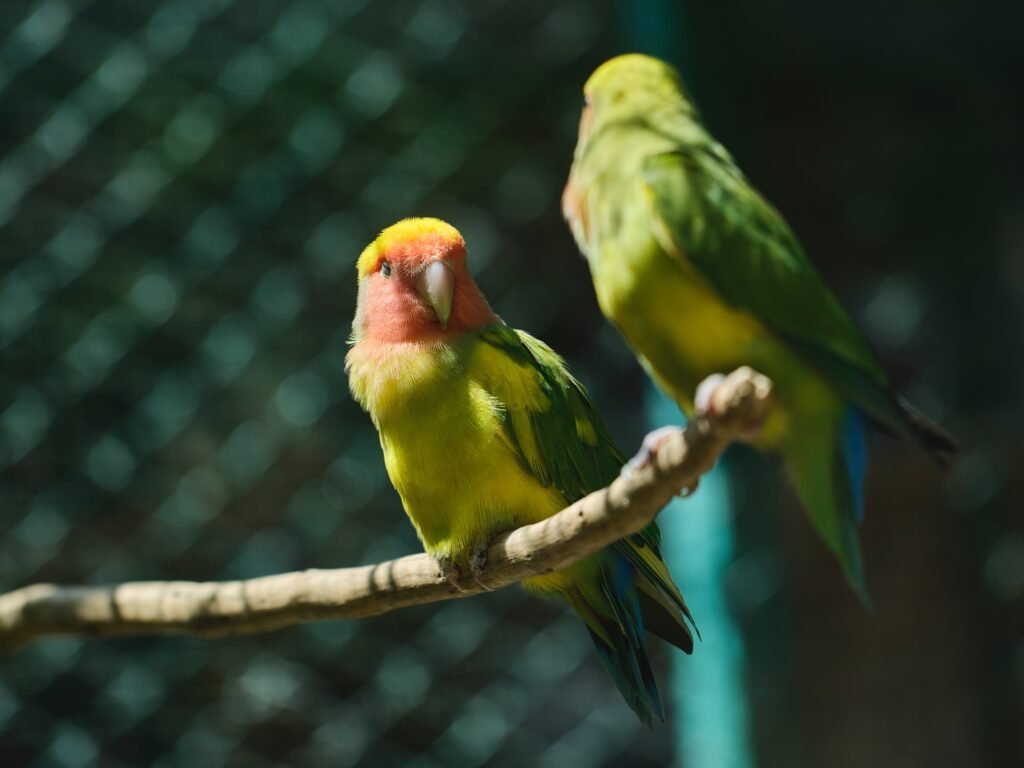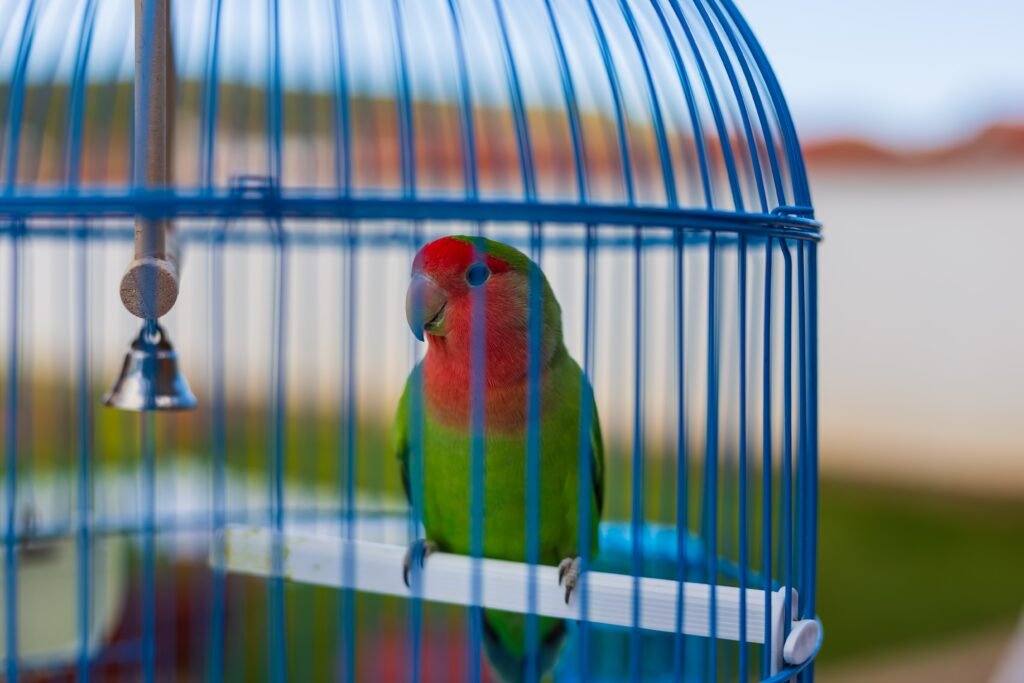Lovebirds are known for their vibrant colors, charming personalities, and, most notably, their vocalizations. These small parrots are excellent communicators and use a variety of sounds to express their emotions, convey messages, and interact with their human companions. Understanding the language of lovebirds is key to building a strong bond with these delightful creatures. In this article, we will explore lovebirds’ different types of vocalizations and what they mean.
The Importance of Vocalization in Lovebirds
Vocalization is an essential aspect of lovebird behavior. These avian creatures use their voices to communicate with each other, establish territories, and express their emotions. By understanding their vocalizations, lovebird owners can interpret their pets’ needs, desires, and current state of being, leading to a more fulfilling and enriching relationship.
Lovebirds have a diverse range of vocalizations that serve various purposes. These vocalizations can be categorized into different types, each with its meaning and significance. By recognizing and interpreting these vocalizations, lovebird owners can better understand their pets and provide the necessary care and attention.
Types of Lovebird Vocalizations
- Chirping and Chattering
Chirping and chattering are the most common vocalizations made by lovebirds. These soft, musical sounds are often part of their daily routine. Lovebirds chirp or chatter when they wake up, during playtime, and before sleep. This cheerful vocalization signifies contentment, happiness, and a sense of well-being.
- Chirping and chattering allow lovebirds to express their general satisfaction and enjoyment of their environment.
- These vocalizations can also indicate that the lovebird feels safe and secure in its surroundings.
- Lovebirds may engage in chirping and chattering as a form of self-soothing or to establish a sense of comfort and familiarity.
- Whistling
Whistling is another vocalization commonly heard from lovebirds. They mimic various sounds and melodies, including human whistling, tunes, and even the sounds of other birds. Whistling is often a sign of affection, playfulness, and an attempt to communicate with their human companions.
- Lovebirds may whistle to get their owner’s attention or to express their desire for interaction and engagement.
- Whistling can also be a form of entertainment for lovebirds, as they enjoy imitating and exploring different sounds.
- Lovebird owners need to respond positively to whistling, as it reinforces the bond between the bird and its human companion.
- Squawking and Screaming
While lovebirds are generally known for their melodic songs, they can also produce loud and piercing squawks or screams. These vocalizations are usually signs of distress, fear, or a response to a loud noise or perceived danger. It’s important to identify the cause of their distress and provide reassurance and comfort to help calm them down.
- Squawking and screaming in lovebirds should be taken seriously, as they may indicate a state of heightened anxiety or fear.
- Common triggers for these vocalizations include sudden loud noises, unfamiliar or threatening environments, or the presence of predators.
- Lovebird owners should create a safe and secure environment for their pets to minimize squawking and screaming episodes.
- Purring and Clicking
Lovebirds have a unique vocalization called purring or clicking. This sound is produced by quickly clicking their beaks together. Purring is often associated with relaxation, contentment, and overall satisfaction. Lovebirds may purr when they feel comfortable and safe or during social interactions with their owners or other lovebirds.
- Purring and clicking are signs that lovebirds are in a state of relaxation and contentment.
- Lovebirds often purr when they are being gently stroked or enjoying the company of their human companion.
- This vocalization can also indicate that the lovebird feels secure and bonded with its owner.
- Mumbling and Talking
Some lovebirds can mimic human speech, albeit to a limited extent. They can learn and imitate words and phrases with practice and repetition. Lovebirds enjoy the attention and praise they receive when they successfully imitate human speech, making it an engaging and rewarding activity for both the bird and its owner.
- Lovebirds that mimic human speech may engage in mumbling and talking to seek attention and interaction from their owners.
- This vocalization can be a form of entertainment for both the bird and its human companion as they engage in conversations and playful interactions.
- Lovebird owners should encourage and reward their pet’s attempts at mimicking human speech, as it strengthens their bond.
Interpretation of Lovebird Vocalizations
Understanding the meaning behind lovebird vocalizations requires careful observation and familiarity with their body language. Here are some common interpretations of their vocalizations:
- Soft Chirping: Contentment and relaxation.
- Loud Squawking: Distress, fear, or a call for attention.
- Whistling: Playfulness, affection, and an attempt to communicate.
- Purring or Clicking: Satisfaction, relaxation, and comfort.
- Mumbling and Talking: Imitation of human speech for attention and interaction.
By paying attention to the context in which the vocalizations occur and observing the accompanying body language, lovebird owners can better understand their pets’ needs and emotions.
Tips for Communicating with Lovebirds
To effectively communicate with lovebirds, consider the following tips:
- Spend Quality Time: Regularly engage in interactive play sessions and socialize with your lovebird to strengthen your bond.
- Lovebirds thrive on social interaction, so spending quality time with them is essential for building a strong relationship.
- Engage in activities your lovebird enjoys, such as playing with toys, teaching them tricks, or simply providing companionship.
- Observe Body Language: Pay attention to your lovebird’s body language, such as fluffed feathers, dilated pupils, or raised crest. It can provide valuable insights into their current mood and emotions.
- Understanding your lovebird’s body language is key to their vocalizations and well-being.
- Learn to recognize signs of stress, relaxation, or contentment in your lovebird’s body language, as it will help you respond appropriately.
- Respond Appropriately: Respond to their vocalizations with appropriate actions. Provide reassurance and comfort when they seem distressed and engage in play or conversation when they seek attention.
- Lovebirds rely on their human companions for comfort and reassurance, especially during distress.
- Responding to their vocalizations with patience and understanding will strengthen your bond and promote a sense of security.
- Create a Calm Environment: Lovebirds thrive in a calm and peaceful environment. Minimize loud noises or sudden disturbances that may cause them stress or anxiety.
- Lovebirds are sensitive to their surroundings, and a calm environment is essential for their well-being.
- Avoid exposing them to loud music, excessive noise, or sudden environmental changes, as it can negatively impact their behavior and vocalizations.
- Learn Their Preferences: Lovebirds have individual preferences, so take the time to understand what they enjoy, whether it’s a particular toy, treat, or type of interaction.
- Each lovebird is unique and may have specific toys, treats, or activity preferences.
- Experiment with different options to see what your lovebird responds positively to, and tailor your interactions accordingly.
Conclusion
Lovebirds have a rich and varied vocal language, which is their primary communication. Lovebird owners can deepen their bond with these charming creatures by understanding their different vocalizations and interpreting their meanings. Quality time, observing body language, and responding appropriately to their vocal cues are essential for effective communication. Remember, lovebirds are highly social and intelligent pets, so nurturing a strong connection through their vocal language can lead to a fulfilling and joyful companionship.
Note: This revised blog article has been formatted in markdown format for online publishing.
Lovebirds Vocalization: Understanding the Language of Lovebirds – FAQ
Q: What are the different types of vocalizations made by lovebirds?
A: Lovebirds make various vocalizations, including chirping and chattering, whistling, screeching and screaming, purring and clicking, and mumbling and talking.
Q: What does chirping and chattering signify in lovebirds?
A: Chirping and chattering in lovebirds indicate contentment, happiness, and a sense of well-being. It can also signify that the lovebird feels safe and secure.
Q: Why do lovebirds whistle?
A: Lovebirds whistle to get their owner’s attention and express their desire for interaction and entertainment. Whistling reinforces the bond between the lovebird and its human companion.
Q: What does squawking and screaming in lovebirds indicate?
A: Squawking and screaming in lovebirds usually indicate distress, fear, or a response to a loud noise or perceived danger. Identifying the cause and providing reassurance and comfort to calm them down is important.
Q: What does purring or clicking signify in lovebirds?
A: Purring or clicking in lovebirds indicates relaxation, contentment, and overall satisfaction. Lovebirds may purr when they feel comfortable and safe or during social interactions with their owners or other lovebirds.
.


